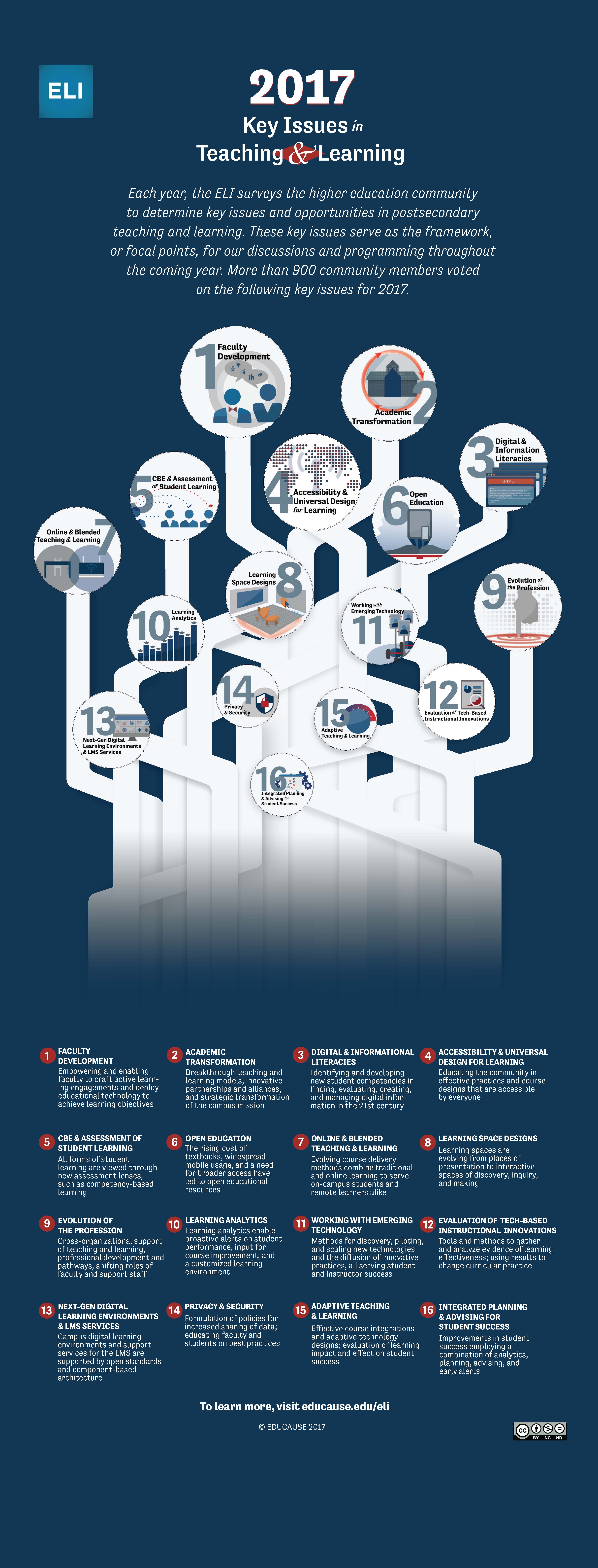Since 2011, the EDUCAUSE Learning Initiative (ELI) has surveyed the higher education teaching and learning community to identify its key issues. This year, the top three dominant issues within colleges and universities include those around faculty development, academic transformation and digital and information literacies.
The community polled by the ELI is wide in scope: the initiative solicits input from all those participating in the support of the teaching and learning mission, including professionals from the IT organization, the center for teaching and learning, the library, and the dean’s and provost’s offices.
According to college and university thought leaders, these are the 16 biggest teaching and learning issues in 2017:
1. Faculty Development: Empowering and enabling faculty to craft active learning engagements and deploy edtech to achieve learning objectives.
2. Academic Transformation: Breakthrough teaching and learning models, innovative partnerships and alliances, and strategic transformation of the campus mission.
3. Digital & Informational Literacies: Identifying and developing new student competencies in finding, evaluating, creating, and managing digital information in the 21st century.
4. Accessibility & Universal Design for Learning: Educating the community in effective practices and course designs that are accessible by everyone.
5. CBE & Assessment of Student Learning: All forms of student learning are viewed through new assessment lenses, such as competency-based learning.
6. Open Education: The rising cost of textbooks, widespread mobile usage, and a need for broader access have led to open educational resources.
7. Online & Blended Teaching and Learning: Evolving course delivery methods combine traditional and online learning to serve on-campus students and remote learners alike.
8. Learning Space Designs: Learning spaces are evolving from places of presentation to interactive spaces of discovery, inquiry, and making.
(Next page: Teaching and Learning issues from ELI 8-16; infographic)
9. Evolution of the Profession: Cross-organizational support of teaching and learning, professional development and pathways, and shifting roles of faculty and support staff.
10. Learning Analytics: These enable proactive alerts on student performance, input for course improvement, and a customized learning environment.
11. Working with Emerging Technology: Methods for discovery, piloting, and scaling new technologies and the diffusion of innovative practices, all serving student and instructor success.
12. Evaluation of Tech-Based Instructional Innovations: Tools and methods to gather and analyze evidence of learning effectiveness; using results to change curricular practice.
13. Next-Gen Digital Learning Environments & LMS Services: Campus digital learning environments and support services for the LMS are supported by open standards and component-based architecture.
14. Privacy & Security: Formulation of policies for increased sharing of data; educating faculty and students on best practices.
15. Adaptive Teaching & Learning: Effective course integrations and adaptive technology designs; evaluation of learning impact and effect on student success.
16. Integrated Planning & Advising for Student Success: Improvement in student success employing a combination of analytics, planning, advising, and early alerts.
For much more detailed information on these 16 teaching and learning issues for higher ed, visit the ELI site here.
Infographic
- 25 education trends for 2018 - January 1, 2018
- IT #1: 6 essential technologies on the higher ed horizon - December 27, 2017
- #3: 3 big ways today’s college students are different from just a decade ago - December 27, 2017


